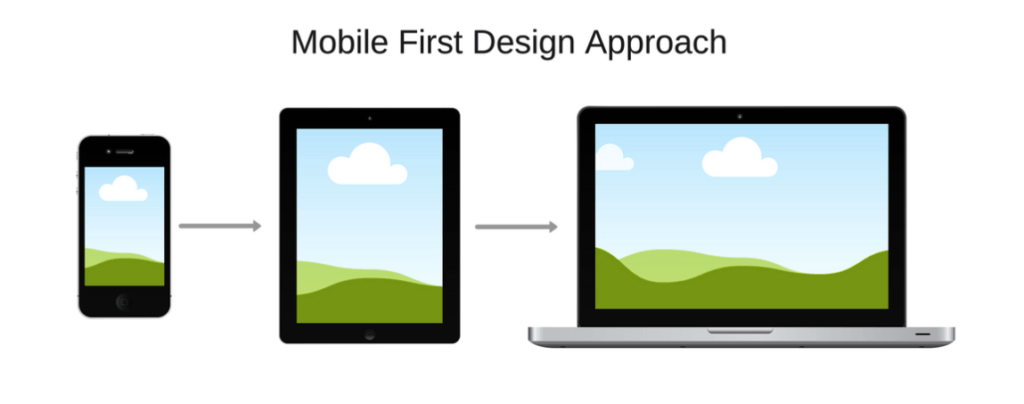Life on this planet is becoming increasingly mobile. From the way we communicate and learn to the way we do business, we have come to rely on our smartphones for our relationships, finances, health, and wellbeing. This has led to some major shifts in such long-established industries such as banking, retail, and travel, as well as creation of new areas of opportunity outside of them. More businesses are adopting a comprehensive, mobile-first strategy to meet the challenges of the new age.
What does this mean for your business? How can you turn it to your advantage? Here is our comprehensive guide to the benefits and best practices for building a mobile-first business.
Thus, the term was used to denote a design approach where you start with the smallest screen resolutions, designing mobile experiences first, and work your way up to complement larger screens.

While traditional design prioritized desktop design considering mobile UI a “secondary,” downsized version of a product, this new method offered a much leaner approach to design. Instead of building a full-fledged product to later find out that half of its capabilities cannot be implemented on mobile, you focus on what’s important initially and add more elements and features if needed later.
However, the term “mobile” can apply to mobile web as well as mobile applications, with both aspects being equally important for any modern business. While mobile apps reduce the distance to your customer, allowing for personalized interactions with the users and serving as an advanced data source, mobile web should not be ignored. Your website’s responsiveness and its ability to adapt to any screen size and resolution directly impacts its search engine rankings: With its latest update, Google can ban your website from its search engine if it’s not optimized for mobile devices.
As 75 percent of internet use is expected to come from mobile devices in 2017, according to Reuters, mobile first is no longer just a design principle. It’s a way of doing business. More companies across the globe, from small local businesses to major enterprise organizations, are actively adopting a mobile-first strategy. But should you follow their example? And how will this strategy impact your current business?
To answer these questions, let’s find out why mobile-first strategy is so popular and what benefits it provides.
Besides that, here are the main reasons to make sure your business is truly mobile first.
With so many advantages, a mobile-first approach seems to be an indispensable business strategy. To maximize the benefits of adopting this strategy, apply these simple principles.
Moreover, this allows you to make sure there will be no integration issues when you launch your mobile product: If your business processes and systems are stuck in the 1990s, the chances are they won’t be able to integrate and efficiently interact with your new mobile products.
Optimized performance and speed is a vital element of any mobile product; so, you must focus on that as well. If your app takes too long to load or has multiple issues, your customers will most likely churn after the first use.
Another important aspect of building a mobile-first business is to check that your backend systems are tailored to support mobile tools as well as web products. In this case, microservices architecture and RESTful APIs prove to be must-haves of a winning mobile-first blueprint.
Moreover, Agile methodologies prioritize testing and validated learning, both very important for business products: The sooner you learn what’s working in your app and what’s not, the better.
With Agile, you can efficiently manage in-house staff as well as hire a remote, dedicated software engineering team. A great way to contribute to your business flexibility, you will be ready to pivot and grow your team fast and economically, if needed.
By expanding your portfolio with more customer-facing mobile products, you increase your likelihood of success. The more facets of your business digitized, the better. By introducing new products from time to time, you keep existing customers engaged and grow your customer base.
A pivotal issue to consider when building your mobile apps is the tech stack. While cross-platform development seems like a good option, it might not always be able to deliver the performance and user experience customer-facing apps require. Thus, you should go with an Android/iOS native development or choose Xamarin.
Among chat-based customer support tools, AI powered virtual assistants are gaining wider adoption. Using a smart chatbot on Facebook Messenger, Whatsapp, or your website online chat, you can significantly reduce the effort and cost of customer support. By resolving simple and generic requests automatically with the help of AI, you can reallocate your resources to other tasks.
Data analytics and machine learning solutions are driving innovations in many business components. Depending on the industry you operate in, you can use it to personalize your customer experience and provide tailored content suggestions, or simply offer an easier, faster, or cheaper way to solve customer problems.
Seamlessly connecting to dozens of other devices wherever we go, smartphones bridge the gap between different parts of our life, making our day-to-day activities more efficient and autonomous. Using your smart home devices, a connected car, or a fitness tracker you wear on your wrist as a gateway, businesses can offer meaningful customer experience and 24/7 support.
Leading global retailers have come to prioritize the mobile-first approach as an essential part of their digital transformation initiatives. Among them are Domino’s Pizza, Starbucks, Walmart, and Target. (You can learn more about their digital transformation strategies from our recent article - Digital Transformation in Retail: How Starbucks, IKEA, Walmart, and Sephora Revolutionize Industry.)
There are dozens of success stories about a varied cast of mobile-first companies: from Snapchat to Uber, Spotify, Tinder, Robinhood, and Monzo. The latter became one of the most promising fintech startups to watch, scoring over $45 million in funding.
To reap all the benefits of this approach, you have to incorporate the mobile-first viewpoint across all features of your business, taking the above-listed principles into account.
As Eric Schmidt, Executive Chairman of Alphabet Inc., warned us back in 2010, “Mobile will ultimately be the way you provision most of your services. The way I like to put it is, the answer should always be mobile first. You should always put your best team and your best app on your mobile app.”
And 7 years later, Schmidt's statement is more compelling and truer than ever. Consequently, if you want to build a modern, competitive business, make mobile your top priority for the coming years.
What does this mean for your business? How can you turn it to your advantage? Here is our comprehensive guide to the benefits and best practices for building a mobile-first business.
Mobile First Defined: from Design Principle to Business Strategy
The term was first introduced by Luke Wroblewski in his book Mobile First in 2009. The author addressed the problem of transition from desktop to mobile web design and how teams and organizations, considering unique aspects in mobile web, should adapt design strategies, such as actions, input methods, and layouts.Thus, the term was used to denote a design approach where you start with the smallest screen resolutions, designing mobile experiences first, and work your way up to complement larger screens.

While traditional design prioritized desktop design considering mobile UI a “secondary,” downsized version of a product, this new method offered a much leaner approach to design. Instead of building a full-fledged product to later find out that half of its capabilities cannot be implemented on mobile, you focus on what’s important initially and add more elements and features if needed later.
However, the term “mobile” can apply to mobile web as well as mobile applications, with both aspects being equally important for any modern business. While mobile apps reduce the distance to your customer, allowing for personalized interactions with the users and serving as an advanced data source, mobile web should not be ignored. Your website’s responsiveness and its ability to adapt to any screen size and resolution directly impacts its search engine rankings: With its latest update, Google can ban your website from its search engine if it’s not optimized for mobile devices.
As 75 percent of internet use is expected to come from mobile devices in 2017, according to Reuters, mobile first is no longer just a design principle. It’s a way of doing business. More companies across the globe, from small local businesses to major enterprise organizations, are actively adopting a mobile-first strategy. But should you follow their example? And how will this strategy impact your current business?
To answer these questions, let’s find out why mobile-first strategy is so popular and what benefits it provides.
The Benefits of Mobile-First Business Strategy
By 2019, the number of mobile users is expected to exceed 5 billion. Having a solid mobile strategy in place, you can tap into this huge audience and significantly grow your customer base. Thus, many consumer-centric businesses view mobile as their primary digital tool for revenue and business growth.Besides that, here are the main reasons to make sure your business is truly mobile first.
- Additional competitive edge
- Increased customer reach
- Better customer engagement and retention
- New revenue channels
- Unmatched data source
- Improved customer experience
- Foundation for future innovations
With so many advantages, a mobile-first approach seems to be an indispensable business strategy. To maximize the benefits of adopting this strategy, apply these simple principles.
7 Principles of a Successful Mobile-First Business Strategy
1. Start from within
Before you focus on a customer-facing mobile innovation initiatives, confirm that your internal business processes are in line with your strategy. That means you should assess your mobile maturity level first. If your company has a strong enterprise mobility strategy, you are more likely to win at customer-facing mobile experiences as well.Moreover, this allows you to make sure there will be no integration issues when you launch your mobile product: If your business processes and systems are stuck in the 1990s, the chances are they won’t be able to integrate and efficiently interact with your new mobile products.
2. Optimize existing products for mobile users
If you already have any customer-facing products, be it a website or mobile app, make certain they are current and provide a decent user experience on mobile devices. Any web-based product needs to be responsive by default to be able to cater to the mobile audience, regardless of the device or screen resolution they use.Optimized performance and speed is a vital element of any mobile product; so, you must focus on that as well. If your app takes too long to load or has multiple issues, your customers will most likely churn after the first use.
Another important aspect of building a mobile-first business is to check that your backend systems are tailored to support mobile tools as well as web products. In this case, microservices architecture and RESTful APIs prove to be must-haves of a winning mobile-first blueprint.
3. Embrace agile methodologies
Mobile and agile software development methodologies go hand in hand. An iterative software development approach, it allows you to focus on one thing at a time - perfect for building a robust, lean mobile experience. By scaling your product concept down to an MVP, you prioritize what’s most important, keeping the development timeframe and investment reasonable.Moreover, Agile methodologies prioritize testing and validated learning, both very important for business products: The sooner you learn what’s working in your app and what’s not, the better.
With Agile, you can efficiently manage in-house staff as well as hire a remote, dedicated software engineering team. A great way to contribute to your business flexibility, you will be ready to pivot and grow your team fast and economically, if needed.
4. Invest in new mobile products
If you have an established business, the chances are you didn’t start as a mobile-first company. And that’s totally fine. If Facebook and Google managed to turn their multi-billion dollar businesses into mobile-first, customer-centric organizations, so can you.By expanding your portfolio with more customer-facing mobile products, you increase your likelihood of success. The more facets of your business digitized, the better. By introducing new products from time to time, you keep existing customers engaged and grow your customer base.
A pivotal issue to consider when building your mobile apps is the tech stack. While cross-platform development seems like a good option, it might not always be able to deliver the performance and user experience customer-facing apps require. Thus, you should go with an Android/iOS native development or choose Xamarin.
5. Adopt new customer service channels
Mobile first equals customer first. Mobile businesses are always looking for better ways to serve their customers. In this regard, social media and chat applications are some of the most popular customer support channels, successfully used by such companies as Tesco, Sainsbury, and Samsung. Domino’s Pizza even allows you to order food with a tweet.Among chat-based customer support tools, AI powered virtual assistants are gaining wider adoption. Using a smart chatbot on Facebook Messenger, Whatsapp, or your website online chat, you can significantly reduce the effort and cost of customer support. By resolving simple and generic requests automatically with the help of AI, you can reallocate your resources to other tasks.
6. Leverage customer data
Mobile-centered businesses gain a competitive advantage over traditional brands through access to a huge customer data pool. A simple app might help you gather and analyze tons of data points, be it geolocation, activity, preferences, purchasing behavior, or personal information. This helps you better understand your users and tailor your products and strategy according to their needs.Data analytics and machine learning solutions are driving innovations in many business components. Depending on the industry you operate in, you can use it to personalize your customer experience and provide tailored content suggestions, or simply offer an easier, faster, or cheaper way to solve customer problems.
7. Consider IoT
Mobile technologies open a significant quantity of opportunities for your business. Among them is the use of smart devices, such as Internet of Things, Beacons, and wearables. By integrating third-party tools into your app, you expand its capabilities and offer more advanced features.Seamlessly connecting to dozens of other devices wherever we go, smartphones bridge the gap between different parts of our life, making our day-to-day activities more efficient and autonomous. Using your smart home devices, a connected car, or a fitness tracker you wear on your wrist as a gateway, businesses can offer meaningful customer experience and 24/7 support.
Mobile-First Success Stories
"There's no longer a delineation between how our guests live life and how they shop; they just shop whenever they have time. They want to flow seamlessly across all of our channels ... and we've got to make that happen by having the right underlying architecture."
Casey Carl, Chief Strategy and Innovation Officer for Target
Source - thinkwithgoogle.com
It’s no secret that some of the major tech companies, including Google and Facebook, switched to a mobile-first model several years ago. As for the latter, mobile currently accounts for 84 percent (about $7.2 billion) of the company’s total revenue.Leading global retailers have come to prioritize the mobile-first approach as an essential part of their digital transformation initiatives. Among them are Domino’s Pizza, Starbucks, Walmart, and Target. (You can learn more about their digital transformation strategies from our recent article - Digital Transformation in Retail: How Starbucks, IKEA, Walmart, and Sephora Revolutionize Industry.)
There are dozens of success stories about a varied cast of mobile-first companies: from Snapchat to Uber, Spotify, Tinder, Robinhood, and Monzo. The latter became one of the most promising fintech startups to watch, scoring over $45 million in funding.
Final Word
Plainly, mobile first revolutionizes almost every industry and business domain, even the ones that seemed the most resistant to innovation. But being a mobile-first business is much more than simply making your website responsive and optimizing it for mobile devices. Having a mobile app is no longer enough.To reap all the benefits of this approach, you have to incorporate the mobile-first viewpoint across all features of your business, taking the above-listed principles into account.
As Eric Schmidt, Executive Chairman of Alphabet Inc., warned us back in 2010, “Mobile will ultimately be the way you provision most of your services. The way I like to put it is, the answer should always be mobile first. You should always put your best team and your best app on your mobile app.”
And 7 years later, Schmidt's statement is more compelling and truer than ever. Consequently, if you want to build a modern, competitive business, make mobile your top priority for the coming years.

Maryna is a passionate writer with a talent for simplifying complex topics for readers of all backgrounds. With 7 years of experience writing about travel technology, she is well-versed in the field. Outside of her professional writing, she enjoys reading, video games, and fashion.
Want to write an article for our blog? Read our requirements and guidelines to become a contributor.

